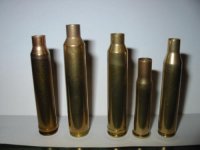IMO unless you have a lot of experience using some sort of "crutch" trying to anneal by eye alone can be difficult, yielding results that are inconsistent. I will say that the progression of color down the case is easier to see on a polished case.
Here is what I suggest. If your cases are of .308 or .223 diameter, get a Hornady annealing kit, and supplement it with some sort of audible timer, so that you can hear the seconds tick off without taking you eyes off the case and flame. A cheap, battery powered metronome set to 60 beats per minute may be the easiest way to do that. Paint a narrow stripe of Templaq down the side of a trial case (that can be cooled and used over and over) and decide where you want the flame to be relative to the case. By putting cases in exactly the same place on the flame, and letting them rotate there for the same number of seconds, you should get repeatable results. After you know the time, the Templaq should not be needed, but you might want to put it on the first few just to make sure that you are doing it right. If you have shined up a few of your cases, ( or all of them if you like) you should be able to see the color below the case shoulder. Be careful about shooting any cases that you have annealed without a way to gauge how far the heat has gone down the case. If their heads were overheated, they could fail under pressure, and you could get seriously hurt. If you do a search using annealing as the search term, on accurateshooter.com, you should find the best article on annealing that I have ever seen. I would suggest that you read it at least a couple of times.


